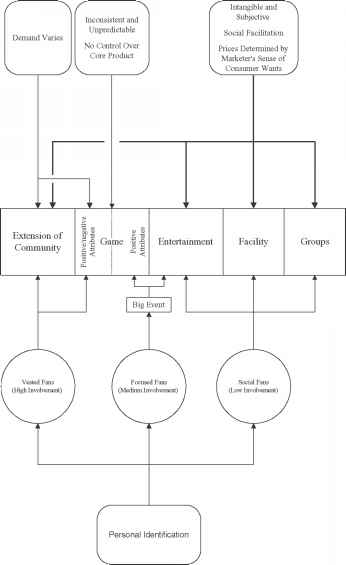The Sport Atmosphere
Many of these elements pertain to several aspects of the total sport experience, whereas some may be related to just one or two. It is important to further classify these elements of the sport product so that situations can be developed that simultaneously address both the unique aspects of sport and the elements of the sport product. We suggest that there are five categories that encompass all classifications of the sport product and define the total sport atmosphere. Figure 14.2 illustrates the unique aspects of sport and their relationship to the sport atmosphere categories.
Three aspects of sport contribute toward the makeup of all five of the sport atmosphere constructs: (a) sport is intangible and subjective, (b) sport enables social facilitation, and (c) prices are determined by the marketer's sense of what the consumer wants. Sport is interpreted in myriad ways by a variety of people. Consequently, the intangible and subjective aspect of sport relates to every component of the sport experience. Because sport is most often enjoyed in groups, the concept of social facilitation also applies to each construct. Additionally, sport marketers cannot always pinpoint what
Unique Aspects of Sport
Sport Atmosphere
Fan Identification
Unique Aspects of Sport

- FIG. 14.2. How the unique, situational aspects of sport contribute to the sport atmosphere.
their customers want, and these wants are embedded in all five of the sport atmosphere constructs.
Extension of Community. This construct contains both the tangible aspects of the organization and the intangible, emotional, elements, such as pride, that are gained vicariously through the team or athletes as representatives of a locale. "Although the success of the team reflects personally upon individual fans, it also reflects upon the collective identity of the community" (Sutton, et al., 1997, p. 17).
The other unique aspects of sport that are a part of this component of the sport atmosphere include (a) personal identification, and (b) demand varies. According to Sutton et al. (1997), personal identification can be broken into distinct levels of fan identification. Vested or high involvement fans use sport as an extension of their community Also, how the community feels about the sport product often determines the ebbs and flows of its demand.
Game. The game combines the game form itself, the participants, teams, and any emotions of the experience tied directly to the outcome of the game. Situations that deal with the status of the team, both before an event and during an event, can be developed from this construct.
Demand also varies depending on the attractiveness of the sport, which is determined by the performance of its athletes. The vested fan also takes an extreme interest in the game and has a strong team identification regardless of how well the athletes are performing. Additionally, the focused or medium involvement fan (Sutton et al., 1997) is attracted to the game itself, but only when it is popular. "Behavior is directly correlated to team performance" (Sutton et al., 1997, p. 17). Additionally, the inconsistent and unpredictable nature of sport is an inherent aspect of the game itself, as is the reality that sport marketers cannot control the core product.
Entertainment. People who are less concerned with the outcome of the sporting event than they are with the overall quality of the entertainment experience characterize this category (Sutton et al., 1997). Relevant situations for this category would include any attempts by the sport producer to enliven the sport atmosphere through manipulation of off-field conditions at the facility.
The focused fan also attends for entertainment reasons other than having an interest in the game itself (Sutton et al., 1997). The big event syndrome is when focused fans "may also be attracted to the 'event,' that being the big game" (Sutton et al., 1997, p. 17). Social or low involvement fans (Sutton et al., 1997) attend primarily for the entertainment value of the sport atmosphere.
Facility. The facility where the sport product occurs, as well as the quality of service that consumers receive, comprise the parts of this category Physical situations related to the condition of the facility and the professionalism of its staff are applied here. As part of their overall sport experience, social fans will engender more satisfaction or dissatisfaction based on their evaluation and enjoyment of the sport facility.
Groups. This final category refers directly to the socially facilitating nature of sport, wherein individuals consume the sport product in groups. With the understanding that the enjoyment of sport is often heightened through group interaction, specific situations in sport can be developed through this construct. Although most sport is consumed in groups, it is the social fans (Sutton et al., 1997) who are more attracted to sport through its "opportunities for social interaction within the community" (Sutton et al., 1997, p. 17).
Was this article helpful?